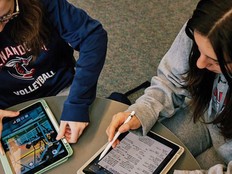Hearables Can Play Many Classroom Roles
Nick Hunn, CTO at WiFore Consulting, says hearables can work to augment audio quality and aid concentration in the classroom.
“There’s some interesting work going on to increase intelligibility of voice, particularly where there is background noise,” he says. “The broadcast features in Bluetooth LE Audio can also help, transmitting to a whole classroom, or providing location-specific information. You can use that for quite localized audio streams, which may be linked to specific tasks, instructing people in physical techniques.”
For students learning English or a foreign language, hearables with translation features already exist, like the AI-powered Ambassador Interpreter, an over-the-ear device that provides language translation and interpretation in 20 languages and 42 dialects. Timekettle’s WT2 Edge earbuds offer bidirectional, simultaneous translation of 40 languages and 93 accents, which could prove useful for a seminar, panel discussion, conference meeting or classroom setting with professors and students of international backgrounds and varying language abilities.
LEARN MORE: About how the user experience of technologies plays a role in the classroom.
According to Athabasca University professor Rory McGreal in an article in The Conversation, hearable tech could have plenty of more general but rather significant applications across the higher ed community: improving communication and rapport between students and teachers; determining the right context or format for lecture delivery; allowing students to play lectures, reminders and notifications; supporting interactivity via text-to-speech applications; and instant replay and recordings to help students with lesson comprehension.
The obstacle, Hunn points out, is in the balance.
“An interesting challenge in learning is to capture attention, and there are certainly applications where hearables can help in that,” Hunn notes. “Like any teaching aid, that needs to be done with care, as there are times when a lack of stimulus helps you think.”
It’s no surprise that by 2030, the market for hearables with biosensors is projected to reach $5 billion. With so many possible uses hearables are bound to find a way into the classroom.










